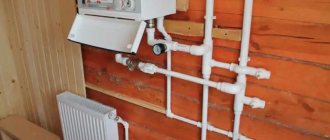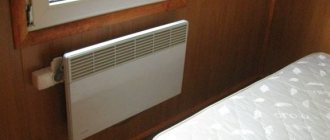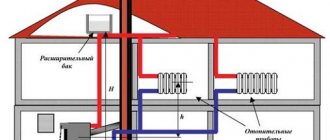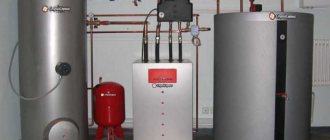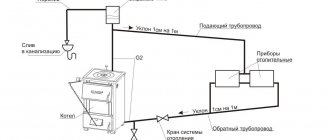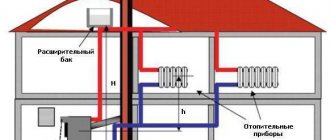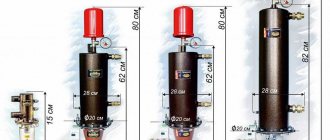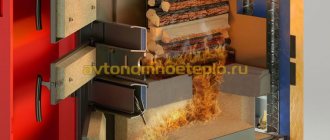Which boiler to choose
On the market you can find different types of boilers for heating an apartment or private house.
In order not to get confused, you need to have a minimum of knowledge about each of them: Electrode boilers. Heating of the liquid occurs due to alternating current that passes through it. This type of electric boiler is considered the most convenient. The efficiency of an electric boiler is not lower than 98% - this is what the manufacturers say.
IMPORTANT: distilled water is not suitable as a coolant. The unit comes complete with compounds, their task is to increase the electrical conductivity of the liquid
The unit comes with compounds, their task is to increase the electrical conductivity of the liquid.
As you can see, the connection diagram is quite simple for both single-phase and three-phase modifications of the boiler.
Heating element boilers are the most common devices; heating elements in them perform a heating function. The units have an efficiency of at least 93%. Despite their low cost, heating element boilers have a serious drawback: if the water is too hard, scale appears on the heating elements, and as a result, the boiler’s power decreases.
This is what a standard heating element boiler looks like.
Induction boilers are durable and economical units that have an efficiency of 98%. The design resembles a transformer. Minus - they cannot produce high power for heating.
Induction boilers are great for an apartment or small private house.
How to make an electric boiler with your own hands
Electric boilers for heating a private house at 220 volts are often made independently - it is not difficult if you have the necessary materials and skills. The simplest boiler is a metal container in which heating elements are installed. Usually they make their own boilers with a power of 6 kW - such equipment is enough to heat a small apartment or country house. A DIY boiler will cost at least half as much as a purchased one. You can make a heating or electrode boiler yourself.
Materials for making a boiler using heating elements
For such a boiler you will need a tank of any shape in which the water will be heated by heating elements. The tank can be made from a 150 mm pipe. For a small boiler, 2-3 heating elements are enough, each costing about $10. Materials:
- steel pipe 150 mm;
- round plates l. 150 mm, 2 pcs.;
- nozzles no less than the contour - 3 pcs.;
- heating elements;
- nuts;
- automatic air vent;
- ball valve
Materials for making an electrode boiler
To make an electrode boiler with your own hands you will need:
- pipe 50 mm;
- steel bar 20 mm;
- flange and coupling with internal thread (2 pcs.);
- any dielectric;
- sealing rubber;
- bolts, nuts.
Detailed manufacturing instructions are presented on many websites on the Internet, so we will not repeat ourselves. There you can also see descriptions and connection diagrams for a simple control unit with a temperature sensor.
Greetings, comrades! There are many myths surrounding electric heating systems, created by false advertising. Today I will dispel some of them and tell you how different electric boilers differ from each other and how to properly connect such a device.
How to save on heating using an electric boiler
Since the cost of electricity is higher than the price of gas, heating a home using an electric heater is considered uneconomical.
However, if you listen to the recommendations below, you can make such a heating system less expensive:
- Install a two-tariff electric meter. If the device operates at full power only at night, when electricity is cheaper, this will provide significant savings. This is especially convenient if during the daytime all household members are outside the house.
- Use automatic systems that control the operation of the boiler. They start the unit only when the room temperature drops below the set value. The rest of the time the boiler will be turned off.
- To make the radiators heat up more efficiently, install the electric boiler at the lowest point of the heating circuit.
- Install heated floors. Thanks to this, the heat will be more evenly distributed and consumed.
- Install heat accumulators and use them in conjunction with a two-tariff meter. As a result, the boiler will heat the water in such an accumulator at night, and during the day, heating of the premises will occur due to the liquid heated at night without turning on the heating equipment.
And one more recommendation for increasing the energy efficiency of the heating system of a private home. Be sure to properly insulate the building envelope and install high-quality sealed windows. This will reduce heat loss in the premises, which will lead to less frequent startup of heating equipment.
Main process
Installing the unit
First you need to install an electric boiler indoors. As we have already said, the unit can be floor-mounted or wall-mounted. In the first case, the kit includes a special stand on which the “landing” is done.
In order to hang the boiler on the wall, you need to prepare anchors with dowels and a drill with a suitable drill bit. First, mark the wall using a tape measure and a marker. The holes must be placed perfectly level in a horizontal plane. Next, we drill out the marked places, drive dowels into them and screw in the anchors. After the anchor is firmly seated inside the wall, you can hang the electric boiler.
We draw your attention to the fact that the product must be installed perfectly level in both horizontal and vertical planes. Any misalignment can affect the performance and service life of the equipment
We connect the electrical wiring
Since an electric water heater has more power, it is necessary to connect it not from an outlet, but directly from the mains. To do this, a separate line must be drawn from the distribution box in the room, going to the boiler connection point. It is better to use underground cable routing, because... in this case, the line will be protected from mechanical damage and the appearance of the room will not deteriorate.
It should be noted that to power the water heater it is necessary to use a large cross-section cable that can withstand fairly high current loads. How to correctly calculate the cable cross-section. We spoke in the corresponding article, which we strongly recommend that you read.
So we draw your attention to the fact that small-power water heaters (up to 7 kW) can be connected to a single-phase network, which is often found in Khrushchev-era buildings and old-style apartments. Well, the last nuance at this stage that you should know about is that electric boilers up to 3.5 kW can operate from an outlet, and not from a separate line from the distribution box. Low-power boilers are ideal for connection in an apartment, because in this case the electrical wiring is usually single-phase and rewiring the cable is not always a practical solution
We install protective equipment
When all the input wires are connected to the electric boiler, it will be necessary to additionally protect it with a circuit breaker and an RCD installed in the main panel. The purpose of the first device is to protect equipment from short circuits and wiring overloads. Connecting an electric boiler through an RCD will protect you from leakage currents.
It is also recommended to install a voltage stabilizer, because even small surges can damage the unit.
I don’t think it’s worth talking about the need to ground an electric boiler. The main requirement is that the grounding wire be led directly from the bus to the equipment housing.
We are launching
When all wiring elements are connected, it is necessary to check all connection points. There should be no exposed contacts, as well as damaged insulation.
It is also necessary to check all couplings, taps and pipe joints. Only after a high-quality inspection of the heating system can you proceed to its start-up. First, we open the valves connected to the equipment, and then turn on the power.
Pay attention to the functionality of the temperature and pressure sensors. Nominal values are indicated in the instructions included with the kit.
In case of obvious deviations, it is better to call a specialist.
We also provide for your attention a clear example of installation work:
DIY video instructions for connecting an electric boiler
Rules for installing an electric boiler
Connecting the electric boiler to the heating system.
Before moving on to a description of the rules and requirements in accordance with which the installation of such heating boilers must be carried out, you need to understand the main design features of an electric boiler. The main feature of boilers of this type, which determines the entire installation process, is the fact that they are produced in a wall-mounted version. As a rule, such boilers are single-circuit in design and do not have a built-in hot water boiler.
To provide a private house or apartment with hot water, as a rule, a flow-through or capacitive electric water heater is installed. If the equipment is installed in a heating system as a backup heat source, and the main boiler runs on diesel, solid fuel or gas, it is possible to connect it to a hot water boiler.
There are a number of general requirements for all devices of this type:
- all work must be carried out by a service center specialist who is authorized to perform electrical installation work;
- you need to make sure that the wall on which the boiler is being installed will support the weight of the unit;
- free space must be left on one or more sides of the boiler for access when performing repairs and maintenance.
Connecting an electric boiler to a heating system
Wall-mounted mini-boiler rooms with a built-in expansion tank, pump and safety group are operated in closed heating systems with forced circulation, operating under pressure. The connection is extremely simple and does not require display in the form of a diagram: the supply and return pipelines are connected to the corresponding pipes of the electric boiler.
Note. The automation of such heat generators monitors the pressure in the heating network using a sensor. If the coolant pressure is below the set threshold (usually 1 Bar), the device will not turn on.
Next, we would like to present typical diagrams for connecting electric boilers to heating systems for the following cases:
- when you need to install a unit that is not equipped with its own pump and expansion tank;
- parallel operation in tandem with a solid fuel or gas boiler;
- piping with buffer tank;
- connecting the dual-circuit version of the unit to the heating and hot water mains;
- connection to an indirect heating boiler.
The safety group protects the system from overpressure and relieves excess air.
The first diagram illustrates the connection of an electrode or induction boiler to a closed-type heating network with a membrane expansion tank. A safety group is installed on the direct outlet section of the supply pipe, followed by a shut-off ball valve. The pump and filter - sump filter are equally well placed on the supply or return side.
Note. This and subsequent diagrams do not conventionally show the make-up pipeline. It should be inserted into the heating return line.
The heating element version of the electric boiler, which is not equipped with an expansion tank, safety group and pump, is connected in a similar way. If it is necessary to organize a connection to an open-type gravity (gravity) heating system, then the pipelines are laid with a slope of 3 mm per linear meter, and the circulation pump is mounted on the bypass.
The ability to work by gravity does not give the circuit a big advantage - without electricity, the boiler will still turn off
An open expansion tank is located at the top point of the network. To ensure stable gravity flow, the manufacturer of electrode boilers “Galan” recommends maintaining the height of the vertical section between the heater and the tank at 2 meters. Accordingly, the tank is placed in the attic of a private house.
Comment. Installing a wall-mounted electric boiler, whose pipes face downwards, will not allow the coolant to circulate naturally due to convection. An example is units of the Evan or Proterm brand. Heaters with side and top fittings - “Galan”, “VIN” and the like - are suitable for gravity systems.
Connection with other boilers and heat storage tank
To connect an electric heat generator together with a solid fuel boiler, use a circuit with two check valves, a surface-mounted thermostat and a room temperature controller. This connection option provides automatic “pickup” of the cooling system by the electric boiler after the firewood load burns out.
Check valves prevent the coolant from flowing into the adjacent circuit and moving in the opposite direction
The algorithm of the circuit looks like this:
- The TT boiler acts as the main one, the electrical apparatus is in standby mode.
- When a portion of firewood or coal burns, the air temperature in the building begins to decrease. When cooling reaches a user-set threshold, the room thermostat turns on the electric heater.
- An overhead thermostat detects a drop in temperature in the return of a solid fuel boiler and turns off its pump.
- After loading firewood into the firebox, heating is resumed and the thermostat starts forced circulation. Using its own sensor, the electric boiler “sees” the heated coolant and does not start working until the next command from the thermostat. The expert explains the operating principle in more detail in the following video:
Note. The piping method is also suitable for other types of boilers - gas, diesel, and so on. Please note one nuance: the electric heater is used here as a backup heat source.
Connecting to a buffer tank, shown in the next diagram, also allows you to combine several heat sources and accumulate a sufficient amount of energy in the tank. The heat accumulator is very useful in a situation where the electric heater operates at night, taking advantage of a cheap tariff. During the day, the device is inactive, and the building is heated with heat from a buffer tank.
In this scheme, you can organize the operation of the electric heater according to a schedule using a timer
The task of the mixing unit with a three-way valve is to supply the radiators with water at the required temperature, because the heat accumulator is “charged” to 80-90 °C. If the rooms have underfloor heating water circuits, a second mixing unit is made for them, preparing the coolant at a temperature of 35-45 °C (maximum - 50 °C).
Schemes with hot water supply
There are two ways to get hot water from an electric boiler for household needs:
- purchase and install a double-circuit heating unit;
- connect an indirect heating boiler to a single-circuit boiler.
In the first case, the device is connected according to the standard diagram shown in the picture. There are a minimum of difficulties here; the main thing is to correctly install the shut-off valves.
For ease of cleaning, the mud pans should be in a horizontal position.
The connection with the indirect heating boiler is carried out through a three-way switching type solenoid valve. At the command of the thermostat built into the storage tank, the element switches the coolant flow to heat water for hot water supply or heating radiators. Loading the boiler is a priority: until the tank warms up to the set temperature, the radiator network will not receive heat.
In the case of an induction or electrode unit, the immersion thermostat is connected to the contacts of the thermal relay
Important point. For this reason, the selection of heat generator power plays an important role. If it is not enough, the heating of the tank will take a long time, and the room air will have time to cool down. For more information about how the system works, watch the training video.
Although the plot talks about connecting a storage water heater to a wall-mounted gas boiler, the essence does not change - an electric heater is connected in the same way.
Installation Rules
When considering how to connect an electric heating boiler, pay attention to the choice of installation location for the unit. Ideally, this is a separate room - a boiler room, equipped with electrical power equipment, where unauthorized persons and children have no access
New models of factory-made electric boilers can be installed in the kitchen.
The heating unit is installed in such a way that there is free space above its top and on the sides. This will make it possible to carry out preventive and repair work in convenient conditions. The following distances are observed
:
- to the ceiling - from 80 cm;
- to the floor (for a wall-mounted model) - from 50 cm;
- from the body to the walls - 5 cm;
- to pipelines - from 50 cm;
- in front of the front panel - from 70 cm.
When learning how to properly install a boiler to heat a house or apartment, pay close attention to the markings of the installation site. The unit must be positioned strictly horizontally, so markings are carried out using a level and the result is checked with the same tool after installing the boiler on the fastening elements.
Mechanical electric heating boiler
Before installing an electric heating boiler, it is necessary to develop a diagram for connecting the heat generator to the heating circuit and to the electrical network. The cross-section of the pipelines must correspond to the parameters of the circulation pump built into the boiler.
When choosing a cable cross-section for connecting to the electrical network, take into account the power of the unit
Please note: for low-power models, a connection to a 220 V household network is sufficient; for powerful units, a three-phase 380 V network is required
In addition to wall-mounted models, manufacturers offer floor-mounted units. Installation of floor-standing electric boilers is carried out using a standard stand or they are installed on a specially prepared site.
Installation and connection
After the heating and hot water circuit with shut-off valves, check valve, safety valve, expansion tank, temperature sensor and heating devices has been assembled, a hydraulic test of the entire system is performed for the tightness of the assembled circuit with the operating pressure of the pump.
The network is filled with water, pressure is created by a circulation pump, and all connections are carefully checked for drips or leaks. All faults are eliminated and we proceed to testing the assembled power supply circuit.
The electrical circuit must be assembled by a certified electrician, who must assemble the circuit with grounding and test the operation of the heating elements and the boiler’s overload protection. To prevent this from happening, install a residual current device.
Advantages and scope of electric boilers
Most often, electric boilers are used when installing heating in a country house and in a private house. This is due to the fact that this equipment has a low cost and at the same time you can install it yourself, without calling a specialist.
Among the main advantages of electric boilers are:
- the equipment is safe (the design does not include open flames or the presence of flammable fuel sources);
- water heaters can be switched off for up to six months, without harm to their performance (relevant for dachas and country houses that are rarely visited);
- the dimensions are relatively small, so it can be placed in any room;
- Today there is a huge variety of electric boilers, varying in power, installation method and principle of operation;
- When water is heated, soot does not appear, which is dangerous for both humans and the environment.
Safety regulations
Before we move on to the main part of heating installation, I would like to pay attention to the safety of electrical installation work. Firstly, the connection of the electric heating boiler must be carried out when the electricity is turned off
Firstly
, the connection of the electric heating boiler must be carried out when the electricity is turned off.
Secondly
, it must be installed at a certain distance from other objects, namely:
- there must be at least 5 cm of free space between the body and the walls;
- the front panel must be accessible for maintenance; 70 cm of free space is enough;
- the distance to the ceiling is no less than 80 cm;
- the distance to the floor is at least 50 cm (if the electric boiler is of a hanging type);
- the distance to the nearest pipes is at least 50 cm.
Third
, the network must be three-phase (380 V) to reduce the current load on the electrical wiring. When using a single-phase network to connect a powerful boiler, the wiring may not withstand it, resulting in spontaneous combustion and.
DIY video instructions for connecting an electric boiler
— professional installation of electric boilers since 2003. The guarantee for the work we perform is at least two years. Minimum installation time. Coordination of electric heating installation with local services!
| Name of works | Explanation | Cost of work, rub |
| Electric boiler installation | For boilers with power from 0 to 30 kW/h | 12 700 |
| Electric boiler installation | For boilers with power from 31 to 60 kW/h | 15 300 |
| For thermal accumulators up to 500 liters | 12 700 | |
| Installation of a heat accumulator for an electric boiler | For thermal accumulators up to 1000 liters | 15 300 |
Types of electric boilers
For domestic use, we recommend the installation of electric boilers with heating elements that have a very high (99.5%) efficiency. There are also. The power adjustment of an electric boiler with heating elements is usually three-stage. For additional adjustment, a room temperature sensor and a timer for daily or weekly programming of the boiler operating mode (on/off) are used.
Remote control of an electric boiler
To save expensive electricity, you can install a system that allows you to remotely change the temperature in a building heated by electricity. At any time you can raise or lower the temperature using your cell phone. Information about the temperature in the building and the condition of the boiler is available for your control at any time.
Placing an electric boiler in a building
The requirements for the location of an electric boiler are minimal compared to a gas or diesel boiler. The compact size of the boiler, the absence of a chimney and the low noise level during operation allow the boiler to be located in close proximity to residential premises or even in them. The best solution is to place the electric boiler in the technical room. It will be convenient if it is located closer to the electrical panel. To prepare sanitary hot water, you can use an additional storage boiler. For additional compactness of the system, you can use hanging DHW boilers.
You can select the electric boiler model in the catalog.
Operation of an electric boiler with a heat accumulator
In addition to external thermostatic control of the electric boiler, you can use a cheap nightly electricity tariff to save money. To do this, we will need a heat accumulator (a tank with a capacity of 300 liters or more), where we will store the heat generated by our electric boiler during the cheap night tariff. We store heat when it is cheap (at night) and spend it on heating when the electricity tariff is at its highest (during the day). During the daytime, the boiler does not operate or operates at minimum mode, only to reheat the coolant. Our designers will select the required capacity of the heat accumulator!
Installation of electric boilers. Guarantees
We provide our Customers with a two-year warranty on the installation of electric boilers. In some cases, the guarantee may be longer!
Drawing
In this boiler design, it is important not only to correctly perform the thermal technical part of the device, but also the electrical one. Therefore, to perform assembly work, the contractor will need an assembly drawing of the unit and a wiring diagram for its electrical part.
Boiler connection diagram
The design of the simplest boiler with heating elements should consist of the following components:
- The pipe body will become more reliable if it is made of steel pipe Ф219х3 mm and 65 cm long.
- Of the 3 pipes: inlet, outlet and drainage, 2 of 30 mm and 13 mm will be sufficient.
- Electrodes are purchased ready-made, depending on the boiler power.
- The housing has holes for supplying the expansion tank and inserting primary sensors.
- Inside the housing there is a platform for fixing the heating elements.
- Prepared pipes are welded to the holes made using an inverter-type welding machine according to the drawings.
You will also need to equip the circuit with the electric boiler with a security system, expansion tank, and thermostat, after which they assemble the pipe circuit with their own hands from polypropylene.
Self-installation rules
We will not describe in detail the scope of work for installing radiators, connecting metal-plastic pipes and connecting them (supply and return) to the boiler terminals. You can see all these stages in the video instructions, which demonstrate the technology for connecting the Galan electrode boiler, which is very popular today:
DIY installation video instructions
https://youtube.com/watch?v=Ox2KDB8DVG0
As you can see, the installation is not complicated, all you need is to connect the pipes, make grounding, connect the automation and make the settings. Even the factory instructions for the equipment describe in detail the entire scope of work. It is much more important to tell you about what rules you need to take into account when installing an electrode boiler with your own hands. So, in order for the system to work for a long time and without emergency situations, we advise you to follow the following recommendations:
- Adjust the coolant (water) according to the requirements of the equipment manufacturer. For example, the Galan company strongly recommends using Argus-Galan liquid as a coolant for such models of electric boilers as Vulcan, Geyser and Hearth, which must be changed independently every 5 years. For the Galan-BeeRT model, you need to use only distilled water. At the same time, the use of antifreezes such as “Arktika” and “Tosol” is strictly prohibited.
- Be sure to flush the old heating system from salt deposits (this requirement is not relevant for a new pipeline). The fact is that contaminated radiators will negatively affect the density of the coolant, which can even worse affect the operation of the electrode boiler. For flushing, it is recommended to use an inhibitor called “Protector”.
- Under no circumstances should the device be connected to the network without grounding. It is recommended to use copper wire with a cross-section of 4 mm2 and a resistance of no more than 4 Ohms as a PE conductor.
- The optimal coolant consumption is 8 liters per 1 kW of equipment power. We do not recommend going beyond this value, because... This consumption allows you to save maximum energy.
- At the highest point of the system, you need to install a deaerator valve (in simple terms, an air vent) to bleed air, as well as a pressure gauge and a non-return safety valve.
- All shut-off valves must be installed behind the expansion tank (as shown in the electrode boiler connection diagram).
- The heater body must be installed in a strictly vertical position, as shown in the photo. Any distortion will negatively affect his work.
- When choosing new radiators, buy products made of bimetal or primary aluminum. Such metals contain the least amount of impurities that have a negative effect on the electric boiler.
- Under no circumstances use cast iron batteries when installing an electrode boiler with your own hands. Such products quickly become dirty and also consume more coolant, which will reduce the efficiency of electric heating significantly.
- You can install several heaters in series (as shown in the video) if the power of one is not enough. It is recommended to use a group of boilers when installing heating in a two-story house (for example, one water heater will serve the first floor, and the second, respectively, the second).
That's all I wanted to tell you about how to connect an electrode boiler in a house or apartment. We also recommend watching a video that talks about the advantages of using EOU - flow-type electrode heating systems, which are popular today.
Advantages of using EOU
Related materials:
- How to connect an electric boiler to the network
- Advantages and disadvantages of heated floors
- Economical methods of electric garage heating
Connection diagram of an electric boiler to the network
Before connecting an electric heating boiler, please note that the electric boiler must be connected to the network using copper wiring. The cross-section of the wire must be no smaller than that specified in the document that came with the device. Electrical connections of the external type device must be made through special cable terminals. These pins should be located in the lower left corner. There should also be a brass grounding terminal with an M6 bolt.
Power cable connection diagram
When inserting an electric boiler into the heating system and installing grounding, you need to ensure that good and reliable contact is ensured between the metal body of the device and the brass bolt. Before connecting the bolt to the frame of the device, you need to thoroughly clean the connection area.
If electric heating is planned to be organized for a building with a large area, then when purchasing equipment you need to choose one that provides the possibility of installing a cascade. In order for the devices to operate normally in a cascade, the terminals of the control device must be connected to the unit that is being controlled. If the system installation is controlled using a room-type regulator, then the control contacts must be connected to the terminals of the control device.
Diagram of the electrical heating system of a two-story house
The device must be inspected visually and make sure that it is in the correct position, the water pressure in the system is normal, and all communications are connected. All this is defined in the unit documentation.
After this, the installation diagram for an electric heating boiler involves the following steps:
- It is necessary to check the serviceability of the pipeline fittings located in front of the unit. To do this, you need to switch it from the “closed” to “open” position, and vice versa.
- All pipeline fittings of the electric heat generator are moved to the “closed” position. It is also necessary to move the pipeline fittings of the water supply and heating systems to this position.
- On those pipelines that supply cold water to the unit, you need to open the shut-off valves. If you use an electric heating system, it is not recommended to use antifreeze liquids for it. This is because they have properties that can affect the operation of equipment in a negative way. Antifreeze fluids have a composition that can cause aging or rapid wear of rubber components.
- It is necessary to install a sump filter or filter before entering the unit on the return pipeline. You can install both of these elements.
- After the heating system is completely filled with water, you need to check how tight it is.
When the installation of an electric boiler with heating radiators is completed, you need to check how efficient the system sensors are. These include sensors such as: temperature controller, water pressure sensor, signal and control components of the unit, emergency temperature sensor.
During repairs to the heating unit or during unfavorable installation conditions, an electric heating unit can be connected using rubber hoses.
For the heating system it is necessary to use water with a minimum hardness level. Then the service life of the heating elements can be significantly extended.
Connection diagram of the electric boiler to the heating system
Currently, two types of heating systems based on an electric heat generator are used. In the first case, natural coolant pressure is applied and the electric boiler is installed in a certain part of the system. The second option involves forced circulation, so heating equipment can be installed anywhere in the system.
Most often, the traditional strapping scheme is used, for which you need to prepare:
- brackets;
- filter;
- shut-off valves;
- safety valves;
- check valves;
- expansion tank;
- thermometer;
- pressure gauge;
- if necessary - pumping equipment.
The most common is a standard connection to the electricity network. Also, the piping may involve the installation of a hot water supply circuit, in which case, before entering the sanitary facilities, the coolant is heated in an electric boiler, and recently the connection of the “warm floors” system has become especially popular. The piping option for a double-circuit heating boiler is always determined by the model features of the equipment.
Diagram of a heating system with an electric boiler
As a rule, the independent wiring and connection diagram of an electric heat generator looks like this:
- collector installation;
- connection to heating equipment using a pipe of the required diameter;
- installation of a three-way mixing valve at the inlet, which helps adjust the temperature regime;
- connection to the “return” of the circulation pump device with subsequent installation of the controller;
- installation of a filter device with a sump filter at the entrance to the heating equipment.
At the final stage of installation, the system is operable and tested.
It should be noted that the connection of an induction electric boiler to the heating system is carried out through a direct and return pipe, and the electrode boiler does not have a built-in safety group, so the connection diagram provides for the use of a pressure gauge, an air vent and an emergency valve.
Electrode electric boilers
Electrode boilers differ from electric heating elements in the way they heat the coolant. This type of electric boiler does not have tubular heating elements. Instead, there are electrodes. The electrode is not a heater; it is capable of transmitting current to the coolant. The water, in turn, heats up due to its own resistance. This occurs due to the interaction of negatively and positively charged molecules at the molecular level under the influence of the electrode.
The most popular in our country is heating a private house with an electric boiler. Reviews confirm this.
Boiler connection
The connection diagram of the unit to the heating system is quite simple; it consists of the following elements:
- a filter that works in tandem with a circulation pump;
- temperature sensors installed on the pipeline;
- expansion tank;
- Radiator;
- drain and shut-off valves.
All modern boilers come with automatic fuses, which prevent the device from malfunctioning during electrical overloads. The coolant temperature is also controlled automatically. Fluctuations are recorded by sensors, and if necessary, the system brings them to normal parameters.
Connection diagram for a heating element electric boiler.
It is worth buying an electric boiler model with a stabilizer for your home, since these devices “painfully” withstand fluctuations in the network. If the boiler was purchased without a stabilizer, you can always purchase this element separately. Don’t forget to study the instructions that come individually for each electric boiler. After this, you can begin connecting the unit to the heating system.
The unit can be installed in both closed and open heating systems. In the first case, a mandatory item is the installation of pressure gauges - in a closed system there is a membrane tank. In the open version, a pressure gauge is not required at all. If a temperature sensor is not installed at home, the unit will operate more economically. Some models come without a coolant sensor, in which case you will have to buy it separately.
Installation Features
During installation of the boiler structure, it is necessary to install a circulation pump - this step contributes to more productive and economical operation of the unit. Another important point is the distribution panel, especially for apartment residents: the boiler needs a separate line. Professionals also recommend installing an RCD. Don't forget to ground.
The equipment must include a box with C16 circuit breakers, which are installed at home next to the unit. As for the cable, a five-core cable (L1, L2, L3, PE, N) is suitable for three-phase, and a three-core cable (PE, L, N) is suitable for single-phase.
The table will help you select the required cable size.
Another important point is the calculation of power. The unit should not operate at maximum power at home, so you need to buy an electric boiler with a power reserve. The indicator depends on the heating area. It is worth calculating the power according to the table:
Useful diagrams
Boiler design with a 2-pipe upper distribution system, circulation in the structure is natural.
Scheme of a 2-pipe version with bottom wiring, forced circulation.
Starting and connecting the system
Safety precautions when connecting an electric boiler at home should come first. You need to launch only if these conditions are met:
- There are no leaks, all components in the system have been checked.
- The connection was made according to the diagram.
- The pressure indicator corresponds to the instructions (the pressure norm is indicated there).
- The electric boiler system is completely filled with water.
IMPORTANT: the first start-up of the equipment takes place at a minimum temperature. If there is no damage and the components are heated, then the temperature can be increased
As you can see, connecting the system is quite simple. The main thing is to completely follow the equipment installation instructions.
Components
After all, to install it, it is enough to fix it on the wall, after which it is connected to the heating system, supplying cold and discharging hot water for double-circuit types, as well as supplying electricity. As a rule, a circulation pump is used for these purposes, but an ordinary centrifugal pump, only of low power, is quite suitable.
Power supply from V is acceptable for them. They are used only for heating warehouse and industrial premises where people stay for a short time. Don't forget to ground.
If we install an induction or electrode boiler, temperature sensors are additionally installed, which are connected by wires to a remote control unit.
Air heating, based on the operation of air heat collectors, is considered no less effective, but practically unknown. If you want to create heating for a private house with your own hands, the schemes are selected based on the possibilities. You can increase or decrease the temperature in each room as needed
Therefore, before assembling the system, it is very important to choose not only the power, but also the type of heat source
Related article: Standards for testing and measuring electrical equipment
Forced movement of coolant in the house
The difference in coolant temperature in the first and last batteries is significant. The diagram for connecting the electric boiler to the heating system in such cases is as follows: The diagram for connecting the electric boiler to the heating system It is recommended to connect the electric boiler to the heating system using metal steel, copper or metal-plastic pipes, which are characterized by a low coefficient of thermal expansion. When cold water enters the unit's tank, condensation usually appears. On the market you can find different types of boilers for heating an apartment or private house.
General diagram of the implementation of a heating system in a house. Therefore, it must be performed at a professional level and taking into account the design features of the system and boiler. Installation of floor-standing electric boilers is carried out using a standard stand or they are installed on a specially prepared site. Heating of small houses is successfully provided by the Leningradka heating scheme, which has as many as four varieties.
Forced circulation. Gas boilers Heating systems with gas units are popular for use in a private home.
They are considered one of the most durable and economical boilers. In order not to get confused, you need to have a minimum of knowledge about each of them: Electrode boilers. Connecting the boiler The connection diagram of the unit to the heating system is quite simple, it consists of the following elements: a filter that works in tandem with a circulation pump; temperature sensors installed on the pipeline; expansion tank; Radiator; drain and shut-off valves. The door needs to be bypassed somehow. Heating with a solid fuel boiler, piping a floor-standing boiler in Orekhovo Zuevo
Disadvantages of electric boilers
Electric boilers have many disadvantages. These include:
- High energy consumption
. In order for home heating to be highly efficient, it is necessary to use powerful equipment that consumes a significant amount of electricity (more details: “Electric boiler: electricity consumption - economical calculations”). From an economic point of view, installing an electric boiler is not the best solution. - Equipment is being improved at a slow pace
. Electric heating devices appeared quite a long time ago, but the principle of their operation has remained virtually unchanged. The purpose of boilers is to transfer coolant within the house. Low-temperature ceramic and film heaters have recently appeared - they are quite efficient (no heat dissipation occurs when transporting water) and economical. - Water is usually used as a coolant
. Therefore, when the heating system is turned off, pipes and radiators may freeze. Electric convectors and oil radiators do not have this disadvantage. To solve the problem, you can also use oil or antifreeze in the heating system rather than water.
Thus, using electric boilers is not the best heating option.
Types of electric boilers
Returning to the choice of electric boilers, I would like to dwell in more detail on power. The larger the heating area, the higher the power of the equipment should be. For example, for a house with an area of 150 square meters, a 14 kW boiler will be sufficient. Such a boiler can easily cope with two radiator heating circuits on the first and second floors and heated floors on the first. The boiler will have a power reserve, which is important in case of critical frosts.
Speaking of power, it is worth noting that this value depends on current and voltage. The greater the power set on the boiler, the higher the current in the power circuit. In turn, the current depends on the voltage: the higher it is, the lower the current will be in the circuit. Therefore, it is best to connect the boiler via a three-phase line.
It remains to figure out the cable cross-section. For example, with a power consumption of 14 kW and a voltage of 380 V at peak load, a current equal to 22 A will flow in the circuit. Such a current can easily be handled by a cable made in accordance with GOST, with a core cross-section of 4 mm square. Typically, such a cable is installed based on 5 full cores (three phases, neutral and ground).
As for the types of electric boilers used by private individuals, here are:
- ten varieties;
- induction options;
- electrode boilers.
Attention. To understand, you need to say a few words about each of the proposed options.
Heating elements new boilers
Such boilers are the most common, have a low cost and are equipped with all important operating components. This includes an expansion tank, a boiling water discharge system, a circulation pump, an automation unit and other components. Based on the name, it is clear that the water is heated by heating elements in special tanks. Depending on the power, the boiler is equipped with one or three heating elements. The greater the power, the faster the water in the circuit heats up.
This system is wall mounted, has a simple and intuitive control interface, and is easy to maintain. As for the disadvantages, thanks to heating due to heating elements, scale inside the container is not excluded. Years later, it can cause the boiler to fail. Although modern models have protective coatings on heating elements against scale, breakdown of the system cannot be ruled out.
Induction electric boilers
Such a system can be called the most modern in its class. Here, induction heating of the core is implemented, which heats the coolant in a very short time. During operation, microwaves (vibrations) are generated, which eliminates the possibility of scale formation. Hence the service life of such systems is 30 years, without the need to replace the heating element. The disadvantages of such boilers include high cost and operation only with coolant under high pressure.
Attention. These are modern models that have been introduced to the market relatively recently, which causes distrust among buyers. Boilers are characterized by heavy weight.
Electrode electric boilers
An electrode boiler is compact, high efficiency, and also reliable. Models with power from 1 to 16 kW are available on sale. The boilers are not sensitive to voltage changes in the network, and, therefore, are more suitable for operation in places with active use of electric heating devices.
Increased danger is the main disadvantage of such a system. To reduce the danger factor, experts recommend installing a grounding circuit. A closed system requires the use of only special liquids as a coolant, the cost of which is high. The system requires attention to itself, and also does not have the ability to smoothly regulate the current.
